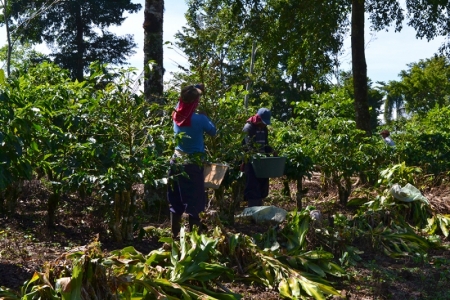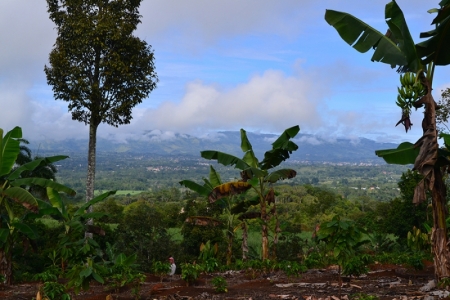If you are like me, you might start your day with a cup of coffee. In that case, you are in a good company, many other Swedes do the same. In fact, according to the Swedish Society for Nature Conservation, Swedes are the #1 coffee consumers in the world, drinking on average 1000 cups per capita annually.
 Organic coffee plantation in Costa-Rica. Photo by Miron Arljung.
Organic coffee plantation in Costa-Rica. Photo by Miron Arljung.
Coffee is the most traded agricultural commodity, the world’s demand for coffee is massive, and satisfying this demand needs space. It is estimated that the area needed to produce enough coffee to satisfy Sweden’s appetite alone is around 100 000 ha of land, or around 143 000 soccer fields. It also happens that most of the world’s coffee growing regions are located in tropical climate zones, often with rainforests that many species call home. So, as you might imagine, whether this coffee is produced through conventional farming methods (with heavy chemical use), or organically, makes a big difference.
Coffee production also has a strong social dimension; coffee fields need people and these people deserve decent salaries and working conditions. On the consumer side, the sort of coffee we demand has a huge impact on what kind of coffee farmers grow.
So, having all that in mind, you rush to a coffee shop to get your morning energy boost, aiming for an organic option. Feeling good about yourself? Yes? Well, it appears it is not a coffee-and-cream coloured choice and one organic differs from another.
During the autumn of 2015, I went to a small coffee farming community of Santa Elena in Costa Rica, and one thing I wanted to explore was how nature -farming symbiosis work at the local level. Costa Rica is a country that is famous for its many national parks and reserves. Although far from being one of the world’s major coffee producers, there are still many farmers who earn their living from growing coffee.
I was especially interested in whether or not they grow organically, and if certifications like Fair Trade had any impact on that decision. As my interviews went on I found that organic farming doesn’t have the same meaning to everyone, and that the perception of what organic means comes not so much from what is or isn’t added to the soil, but rather from one’s worldview, which in turn is heavily influenced by socio-economic context.

Photo by Miron Arljung.
The conventional perspective
During colonial times, agriculture in many Latin American countries was defined by massive farms owned by rich landowners growing only one crop. Coffee was no exception, and even after independence this tradition went on, except that many of these farms became a property of large multinational corporations. The tactic was and often still is to produce large amounts of cheap coffee that would then be exported abroad, processed, roasted and finally sold to (Western) customers for a high price.
While much has changed since colonial times, the modern deregulated coffee market is characterised by constantly fluctuating and often low market prices for the farmers, but a pretty steady high retail price for consumers. This means that middlemen get the biggest share of the money from coffee sales.
Even though many cooperatives have emerged and are trying to “take back” some ownership of the means of production, farmers have to compensate for low income, and so getting as large harvests as possible is still the prevalent strategy. Accomplishing this means using chemicals to combat pests and to increase harvests. According to FAO’s data, import costs for pesticides in Costa Rica has gone from around $90 million in 1997 to around $160 million in 2012. Whether this reflects increased usage or growth in price is not clear, but it tells something about the agricultural norm in the country.
In the context of intensive production, organic farming is understood as a “hands off” approach in which the only real land-use change is that farmers promise to stop using chemicals. In exchange for this “no harm deal” farmers will have a slower and reduced production (about 50%), more parasitic attacks and, if not compensated by higher prices, lower income. This triggers a negative reinforcement loop: because there are so few organic farmers, the cooperatives I interviewed said it would be hard if not impossible to process any organic coffee separately. All coffee is therefore processed and sold together, with no distinction in payment between the two sorts. Because of this lack of monetary compensation for organic production, few farmers are interested in growing organically.
In short, organic farming is framed and understood as a compromising act. It is, sort of a “cold war” where initiatives like Paying for Ecosystem Services, PES only serve to enforce borders and a “no gain, no loss” situation between farming and nature at best.
The agroecological perspective
After almost giving up, I finally found one organic coffee farmer, Pablo, living in Pérez Zeledón. Although not labelling his land-use as anything special besides “organic”, he grows his coffee with what can be called an agroecological approach. This basically means that he re-uses the nutrients on his farm, instead of constantly adding more from fertilizers, and mimics the natural mountain habitat by mixing his coffee with a lot of trees. Pablo also has cows and chickens on his farm that provide manure and he also grows legumes like beans that bind nitrogen to the soil. Instead of growing only one type of coffee plant, he has five; instead of only growing coffee he also has banana, sugar, citrus and trees which he sells as lumber. Altogether this makes a more diversified economy less vulnerable to market changes.
Pablo argues that organic agriculture is a philosophy, that it is a way of life and not only “produce for profit”: “There are many things that can’t be quantified; Because I do not use chemicals I have good health and so do my sons who can go to the farm without harm. This is great value!”
Within this context, organic is not just about the “absence of anything bad”; it is about the additional benefits created when working the land differently, a win-win approach. The cooperatives formed by the conventional farmers use the strategy which relies on high production numbers to help them get larger market shares, but they still sell most of their beans un-roasted abroad which means lower price as the beans are raw.
On the other side of the hill, Pablo has joined forces together with five other organic farmers to create their own coffee brand with their own micro-processing machines, roasting and packaging. Although production is lower, the combination of organic and Fair Trade certification makes the price they get for their produce three times higher compared to what the conventional farmers get. It also makes the price more stable.
So what I have learnt is that we need to better clarify what we mean by “organic”. If we want “organic” to truly benefit both the farmers and nature, we need to move beyond a simply negative definition, based on no chemical use, to a positive definition which would include the added benefits. Instead of basically trying to bribe farmers by means of economic compensation for land use practices which lead to decimated harvests, organic can be a way to help farmers to gain economic independence and to access new ventures, like trendy green brands or ecotourism.
Through their shopping habits coffee lovers have a great power over how coffee is produced. In the last decade, certification schemes have become the main means of helping consumers to make informed purchase decisions. Just like the meaning behind labels like “organic” changes depending on the context, the functions and the value of certification practices on land use can vary too.